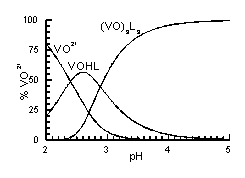
Figure 1.

Figure 2. Species distribution curves for
the VO2+ - H4L1 system; metal
concentration 1 mmol dm-3, ligand concentration 2 mmol
dm-3
Speciation 98: Abstracts
Hydroxyalkylodiphosphonic and alkylodiphosphonic acids are used in medicine as drugs against Paget disease, tumour osteolysis, and osteoporosis, in radiodiagnosis as ligands for 99mTc, as potentially strong chelating agents in metal extraction and as novel antidepressants.
Vanadium is abundant in living systems, although its role is not well understood. Small amounts of vanadium are necessary for the development cells, plants and animals. In a human body vanadium exists in two major oxidation states: V(V) and V(IV) (inside cells).
We report hereby a spectroscopic (EPR and UV-Vis) and potentiometric study of oxovanadium(IV) complexes with four 1-hydroxyalkane-1,1-diyldiphosphonic acids (Fig. 1).
Co-ordination of oxovandium(IV) starts at a very low pH. Stable monomeric (VOHL or VOL for H3L3) and trinuclear species ((VO)3L3 or (VO)3H-3L3 for H3L3) are present between pH range 2-9 (Fig. 2). Even though all ligands studied showed similar co-ordination abilities towards VO(IV) ions, we observed small, but distinct, steric effects of alkyl side-chains.


Figure 2. Species distribution curves for
the VO2+ - H4L1 system; metal
concentration 1 mmol dm-3, ligand concentration 2 mmol
dm-3
